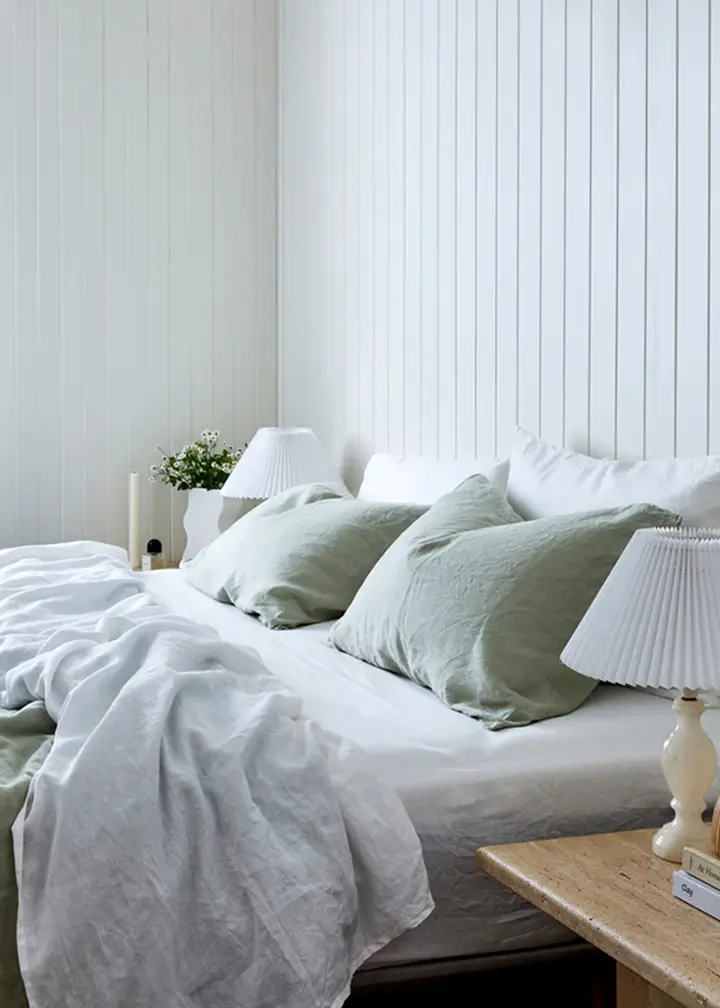
This Is How Your Choice of Pillowcase Can Affect Your Skin
What you put your face on is just as important as what you put on your face.
Considering we spend one third of our lives asleep, it's important to maximise the returns on every one of those elusive Zs we work so hard to catch. When we're sleeping is the perfect time to let our skincare routine really work its magic. Every oil and serum we massage onto our faces needs overnight quiet time to really do its thing, and so what we rest our faces on every night is an important part of the overall process.
Your choice of pillowcase is a crucial factor in how effective your skincare routine is. So, which material is best to sleep on at night? We are big believers in the benefits of 100% French flax linen, if you hadn't already noticed, but let's discuss the pros and cons of some of the common fabrics used to make pillowcases.
Silk
While generally a much more expensive material, silk is a good option for those will severe skin issues and concerns. It's a very soft material, which a lot of people enjoy, but it's also less cosy, especially in the cooler seasons. Silk pillowcases are harder to care for – often demanding dry-cleaning – and can tear easily. Similar alternatives like satin or nylon will be more cheaply available and often claim to have the same effects, but with lower absorbency levels, these options will also make your skin sweat throughout the night.
Synthetic blends
There are lots of synthetic fabrics out there due to the fact that it's cheaper and easy to manufacture. However, pillowcases made of this material don’t breathe as well those made from natural fibres, causing heat and moisture to get trapped between your skin and the pillow, leading to sweating, and a higher chance of breakouts or irritation.
Because synthetic fibres don’t wick moisture or dry quickly, they can harbour bacteria, oil, and dead skin cells, making them a less hygienic choice – especially for people with acne-prone or sensitive skin. Synthetic materials are often treated with chemical dyes or finishes that may cause irritation, which can contribute to friction-related issues like skin inflammation or hair breakage.
Cotton
Cotton is naturally smooth and soft, which means less friction against your face as you sleep. That can help reduce irritation, redness, or inflammation, particularly for people with eczema, rosacea, or easily aggravated skin. It's also naturally hypoallergenic, meaning it's less likely to trigger allergies or reactions. It also doesn't trap heat or moisture easily, reducing the likelihood of breakouts caused by sweat, bacteria, or clogged pores.
If you go to bed wearing serums, oils, or moisturisers, cotton is less likely to “pull” or rub them off harshly than some other materials. Synthetic materials can trap sweat and heat, contributing to breakouts, whereas cotton helps wick moisture away without overheating the skin, keeping your pillow cool, clean, and breathable.
Linen
Durable, anti-bacterial and easy to wash, linen pillowcases make the perfect bedfellows to catch plenty of beauty sleep. No harsh chemicals are used to craft or wash our Bed Threads linen, meaning that sleeping on our pillowcases won’t exacerbate sensitive or acne-prone skin. The absorbency and temperature-regulating technologies of the material prevent facial sweat and adjust to match body temperature, facilitating unperturbed sleep through the night and preventing breakouts simultaneously.
The right pillowcase must also be made of natural fabrics – just like our 100% pure French flax linen – as these will be more breathable and transfer less oils while you sleep. That our Bed Threads come in a variety of colourways, even allowing you to customise your own bundle, means that you can not only sleep soundly in the knowledge that your skin is taken care of, but accomplish this in style, too.
So, if you've made the smart move and have started sleeping on 100% French flax linen pillowcases, keep reading to find out how to care for them properly so you can put your best face forward.
Caring for linen
Ideally, it's best to wash your pillowcases every two to three days – which sounds like a lot but think about how frequently you wash certain items of clothing and it won't seem so over-the-top. Our no-nonsense, no dry-clean linen care instructions make it easy, and without the proper care you risk oils and dirt from skin and hair, as well as the surrounding environment, to build up over time, threatening to clog pores, cause blemishes and irritate sensitive skin.
Then there's acne mechanica, which is the appearance of acne caused by the skin’s interaction with materials or objects, and can be the direct result of too much shut eye on the wrong pillowcase. Besides washing your face nightly before you go to sleep, ensure that your pillowcase is cleaned frequently but also comfortable to sleep on – or watch as it becomes a hotbed of dirt and discomfort that will threaten an inevitable breakout.
Find the Perfect Pillow
Enjoyed This?
Learn more about different fibres.














